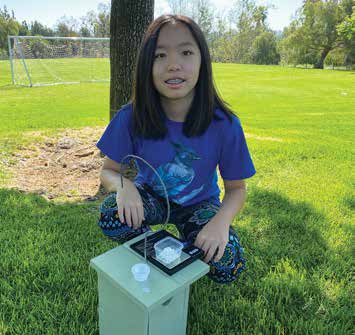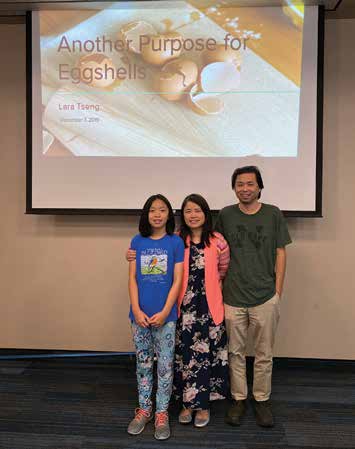How Bluebirds are Helping Me to Become a Conservationist
The Cavity Conservation Initiative and the Southern California Bluebird Club have had the pleasure of working with and supporting Lara Tseng for the past three years. Lara is a young scientist who has a passion for birds and for conservation. We want to introduce you to her. Get ready to be inspired! And do share her story with other youngsters.

From a very early age, I was drawn to birds. The first question I asked about birds was, “Why won’t they let me hold them?” I was three at the time. I am thirteen now. Since then, there isn’t a single day that I don’t seek answers about nature. I love questions that make my world bigger, more interesting, and reveal new discoveries.
Asking questions is how I learned about bluebirds. In 2018 I became a nestbox monitor for the Southern California Bluebird Club (SCBC). The following year I conducted a year-long science project in my backyard. I wanted to see if birds would consume crushed eggshells as a source of calcium. While I found that they did so during the breeding season, the project raised another question. Would the Western Bluebird also do so? This has become my science project for 2020. In this article I would like to describe this project. I would also like to share my interest in technology. I strongly believe that exploring science and learning about technology are keys in helping birds and conserving our planet. I am grateful to NABS for the opportunity to tell my story.
I am an only child. My parents support and help me overcome obstacles to becoming a scientist. Their love and sacrifice nourish my interests in birds, nature, technology, and all the related sciences. My mom gets up before dawn on weekends and during school breaks to get me to classes and events. We often spend hours in heavy traffic. She waits for me at the library or naps in the car.
Around age 10, I discovered to my dismay that my school friends and adult acquaintances often didn’t share my love of nature. In fact, some showed outright disdain. I was surprised, and disappointed. Frustration grew as they dismissed and belittled what I cherish. However, my parents advised me not to take it personally, to respect differing opinions, and most of all to not give up.
As fate would have it, I met my mentor, Ms. Gillian Martin, at a local nature event. She is the founder of the Cavity Conservation Initiative (CCI), a program of the Southern California Bluebird Club (SCBC). She is an inspiration because she works tirelessly to convince people to preserve dead trees for wildlife. Ms. Martin took me under her wing. I began to help out at some of her events. I learned first-hand the need to take action and speak up for causes I believed in. It was up to me to present and convince others that helping birds and conserving nature is important. She illustrated that perseverance is key.

While volunteering at an Arbor Day event, I met the mayor of Mission Viejo, California. He invited me to speak in front of the city council about my experience as a bluebird monitor. The presentation went well but I felt my message about conservation didn’t connect with my audience. I started to wonder how I could improve my public speaking skills to further my cause. Soon after, Ms. Martin introduced me to Mr. Steve Kaye, a professional public speaker as well as a nature photographer.
He kindly tutored me over several weekends. I learned ways to connect with an audience, convey facts in an interesting way, and keep their attention. Mr. Kay called it “owning the room.” One of the most valuable pieces of advice he gave me as a beginner was to be selective about audiences I sought. He suggested I avoid audiences whose minds are likely closed forever. He said I should choose people who are “in the middle,” or uncertain and still open.
“That’s where hope for change lies,” he said.
Mr. Kaye’s teachings helped me speak easily and confidently, even at science and tech fairs. This past winter when I presented the outcome of my 2019 project, and also proposed this year’s eggshell project to the SCBC, I really felt I connected with my audience; so much so that SCBC agreed to immediately provide a $500 grant to fund it.
I am not the first to study this topic. My project was partially inspired by a relevant study by Dr. Andre A. Dhondt of Cornell University titled “Variations in Calcium Use by Birds During the Breeding Season.” It was published in the January 2001 issue of The Condor. The study tested birds’ consumption of crushed eggshells at open feeding stations across North America, but the data did not include mention of the Western Bluebird.
To help me, more than a dozen SCBC monitors volunteered to collect data on 64 nestboxes throughout Orange County. The objective is to see if and when the Western Bluebird will consume crushed eggshells from a small, removable, clear plastic container affixed to the top of each box. Each container holds 5 grams of eggshells. The container has a lid with a small hole in the middle to allow the bird to access the eggshells.
In my study, monitors check the boxes and containers at weekly intervals. They will do this during the breeding season (from March to August). They all use the same model of digital scale (capable of measuring to 0.01 g) to weigh the eggshells to determine if and how much eggshell was consumed. After the weight check, volunteers refill each container back to 5 g of eggshells. Weekly checks also record the status of the nest so eggshell consumption can be compared with the stages of the nesting cycle. Although my data will not be complete until after the publication of this article, I have already seen some interesting consumption patterns by the bluebirds. I will be pleased to share my findings with NABS.
It’s been a challenge coordinating and communicating with all the monitors, managing a project budget, and developing clear and concise procedures. There are ups and downs, of course. I enjoy the supportive messages from volunteers, and the jolts of excitement when I see a bluebird investigating my eggshells. But then there are days when heavy rain delays data collection, or when unexpected issues come up. Nevertheless, I am grateful for all the different experiences that enrich me as a person.
So why did I choose to study eggshells and birds? It was an idea that was born out my concern over how people like to feed junk food to ducks and other birds in our parks. As NABS members likely already know, this can adversely impact the health and migration of birds, as well as public health. If I learn that providing sterilized, crushed eggshells is possible and practical in public places, I hope that people will be persuaded to feed this to birds instead of things like bread, chips, and other junk food.
Beyond my interests in birds, nature, and science, I am also keenly interested in technology, especially programming and computer science. I have been fascinated with biotechnology of late since it encompasses all my interests. Programming algorithms have helped determine biodiversity in an ecosystem as a whole and populations of individual species within a habitat. These algorithms can also be used to provide a platform for citizen scientists to input data on the biodiversity found in their own neighborhoods. They can be applied to understand the behavior of endangered species to help preserve their population and genetic diversity. Using websites and apps could greatly increase awareness and be crucial in educating the public about some of the most urgent problems that we are faced with today.
Skills in software engineering and biotechnology can help me contribute more to protecting animals and conserving nature. So far, I worked on a few demonstration projects such as a website on identifying my local bird species as well as an app that targets people, especially kids, to help conserve nature. These projects competed in Coolest Projects USA (a tech fair for 18 and under), winning 1st in web design in 2019 and 1st in app creation 2020.
While I can’t thank everyone who has supported me in my journey, I do want to acknowledge some key people who greatly shaped who I am today. I met Mr. Lindsey and Ms. Cathy Groves from the Natural History Museum in Los Angeles when I was three years old. The two of them are successful and inspiring scientists and have been incredibly supportive.
There is also Ms. Laura Cohen, a resource specialist at Laguna Wilderness Park who first introduced me to conservation. She is my “nature mom” who has opened up so many new interests and opportunities such as managing my own booth at multiple nature events that the park hosts.
And most of all, I wanted to thank Ms. Martin of the CCI. If it weren’t for a mentor like her, I would not have progressed this far. Through successes and disappointments, she has been there for me.
I am also grateful for the support of my school teachers, principals, and superintendent. Their encouragement and understanding mean a great deal as I work hard for the cause I support.
As I write this, I am thinking of all the conservationists who have come before me and are working earnestly to protect life on our planet. I want to honor them with responsible, helpful actions. While there is much for me to learn, I have my parents, my mentors, Sea & Sage Audubon, and the SCBC to help stay on course. With their support, I know I can make a positive impact for the causes I cherish. Thank you for allowing me to share my story.


Connect
Connect with us on the following social media platforms.